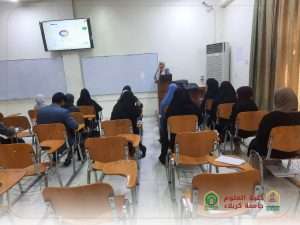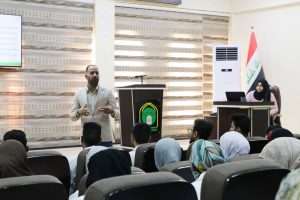The College of Science has discussed the master’s thesis tagged (Study of the Structural and electronic properties of the Polycarbonate using the Density Functional theory) by the student Worood Sami Rasool and under the supervision of Assist. Prof Dr. Mohammed Abdulhussain Alkaabi. The aim of the study is to calculate electronic properties such as electronic energy, dipole moment, charge distribution, boundary orbits, global scalar parameters, and surface molecular electrostatic potential. The calculated energy values were equal to – 845.0676 and – 845.0814 Hartree for BP86 and B3LYP, respectively. The dipole moment values were found to be 3.87 and 3.98 Debye indicate the non-uniform distribution of charges. The result of the charge distribution shows the highest negative charge on the O19 (-0.708 and -0.727) and the highest positive charge on the C17 (0.969 and1.035) for the two DFT methods. The energy gap was found to be 4.383 and 5.891eV, which reflected the stability of the molecule. In addition, theoretical vibrational analysis has been carried out using FT-IR, FT-Raman, UV-vis, and NMR techniques.
One of the most prominent conclusions of the research is the termination of the polycarbonate monomer by two hydrogen atoms makes the relaxation of the geometry very easy and leads to fair results and the results obtained by B3LYP are better than those of BP86 in bond lengths. Energy gap evaluation using B3LYP method gives a more stable molecule than BP86 and both are acceptable compared to the optical bandgap. On the other hand, the dipole moment values (3.87 and 3.98) Debye using both methods indicate the non-uniform distribution of charges on the different atoms of the molecule. There is a good agreement between the infrared and Raman spectra with the experimental FT-IR and FT-Raman spectra. In the NMR spectrum, it was found that the shift The chemistry of carbon atoms (except for C13-C15) calculated using B3LYP is better than the values of the BP86 method. The chemical shift values of hydrogen atoms are also better than those evaluated using the B3LYP method.
It recommended to do density functional calculations for changes in the structural and electronic properties of polycarbonate produced by Ag + ion implantation, study the electronic and spectral properties using other programs such as Spartan or Avogadro and compare the results with those of the Gaussian program. In addition to highlighting the compounds used in physical applications and making its density functional theory calculations.































































